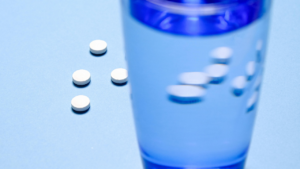Heroin is a well-known and highly addictive opioid drug that has been widely studied for its harmful effects on both the brain and the body. Derived from morphine, a substance extracted from the seed pod of certain varieties of poppy plants, heroin has been utilized as a recreational drug due to its powerful ability to induce feelings of euphoria and a state of intense relaxation.
However, the dangers associated with its use far outweigh any temporary pleasure, causing life-threatening health problems and severe social and psychological disturbances. Make no mistake: There is no such thing as “safe” or “casual” heroin use. Heroin kills and with the prevalence of fentanyl now found in more than 70% of street heroin, it’s deadlier than ever.
This article from The Bluffs will delve into the complex ways that heroin interacts with the brain and body, why it is so dangerous and what can be done to help people conquer heroin addiction with effective treatment.
How Heroin Works in the Brain
The human brain is an intricate network of billions of neurons that communicate with each other through chemical signals known as neurotransmitters. One of these neurotransmitters, dopamine, plays a significant role in the reward circuit – a group of neural structures responsible for motivation, desire, pleasure, and positive reinforcement.
Heroin works by imitating endorphins, the body’s natural painkillers structurally similar to opiates. When heroin enters the brain, it is converted back into morphine and binds to mu-opioid receptors. The activation of these receptors triggers a chain reaction that ultimately results in the increased release of dopamine.
This surge of dopamine in the brain’s reward center produces an intense feeling of pleasure or euphoria, a “rush” that users often describe as the ultimate driving factor of heroin addiction. Over time, the brain becomes reliant on the drug to produce these feelings of pleasure, leading to physical dependence and addiction. The physical withdrawal symptoms from heroin can be intense and usually require a medical detox for comfort and safety.
The Needle and the Damage Done
Repeated heroin use alters the physical structure and physiology of the brain, leading to long-term imbalances in brain function that are not easily reversed. These biological changes can conspire against a person’s best efforts to quit using heroin.
They are a major reason why long-term treatment for heroin addiction is often what it takes to break the cycle of abuse. Neuroimaging studies have shown that chronic heroin use can lead to the deterioration of the brain’s white matter, which may affect decision-making abilities, the ability to regulate behavior, and responses to stressful situations.
Chronic heroin use also shuts down the brain’s production of endogenous opioids, which are some of the natural “feel good” chemicals we rely upon for balance. This shutdown can lead to a condition known as anhedonia, which is basically an inability to feel pleasure. Anhedonia can continue for some time, even after a person stops doing heroin. It should be no surprise that it is one of the major causes of relapse among heroin users.
How Heroin Hurts the Body
Apart from the negative effects on the brain, heroin use also has some pretty serious effects on the body. You can forget that old myth about heroin “preserving” people or keeping Keith Richards alive. It’s all nonsense. The truth is heroin slows down the functioning of your nervous system, which controls heart rate, breathing, and blood pressure. This effect is what least to fatal respiratory failure in overdose situations.
Heroin’s impact on the body even weakens the immune system, making people more likely to ge infections and diseases. Long-term heroin users may also experience malnutrition due to changes in metabolism and appetite.
Injecting heroin introduces a set of additional risks, including infection, collapsed veins and abscesses at the injection site. Users sharing needles are also highly likely to contract blood-borne diseases such as HIV and hepatitis.
Withdrawal and Addiction
Repeated heroin use leads to a physical dependence on the drug, whereby the body has adapted to the presence of the drug and withdrawal symptoms occur if use is reduced abruptly. Withdrawal symptoms can be extremely uncomfortable, including restlessness, muscle and bone pain, insomnia, diarrhea, vomiting, and severe cravings.
The distress of withdrawal, coupled with the psychological need to experience the drug’s pleasurable effects again, leads to a vicious cycle of addiction. Needless to say, heroin addiction is complex, so successful treatment of heroin addiction needs to be sophisticated enough to attack this disease on all fronts.
It’s not enough to simply get a heroin detox and hope for the best. Long-term treatment and the adoption of a recovery lifestyle are essential. They can literally be a matter of life or death to the a person with heroin addiction.
Heroin Addiction Treatment in Ohio
Heroin addiction doesn’t have to be a life sentence (or a death sentence). As impossible a mountain as this may seem to be to climb, millions of people have successfully recovered from heroin addiction. You or the person you love can do it too. We won’t tell you it’s easy, but we can say that the road ahead is already mapped out for you. All it really takes to “get recovery” is an open mind and the willingness to follow some simple directions, even when you don’t feel like it. The life that awaits you in recovery on the other side is more than worth what it takes to earn it, we can promise you that.
Interested in heroin addiction treatment in Ohio? Give The Bluffs a call at 330-919-9228. Let’s talk about it.








